FIN203 Banking & Finance: NBFIs Assessment Post Deregulation
VerifiedAdded on 2023/03/23
|14
|3405
|92
Report
AI Summary
This report assesses the evolution of Non-Bank Financial Institutions (NBFIs) in Australia, particularly building societies and credit unions, following the deregulation of the financial sector. It examines the trend of these institutions restructuring into banks, using Defence Bank and Heritage Bank as examples. The research explores the rationale behind this shift, driven by factors like the pursuit of scale, enhanced competitiveness, and public perception. The report also discusses the implications of this trend, including the strengthening of the financial sector and the increased risks associated with larger, more competitive institutions. Recommendations include encouraging more credit union mergers and strengthening government monitoring of the banking sector. The report concludes that while the transformation of NBFIs into banks contributes to a stronger financial sector, careful oversight is necessary to manage the associated risks.
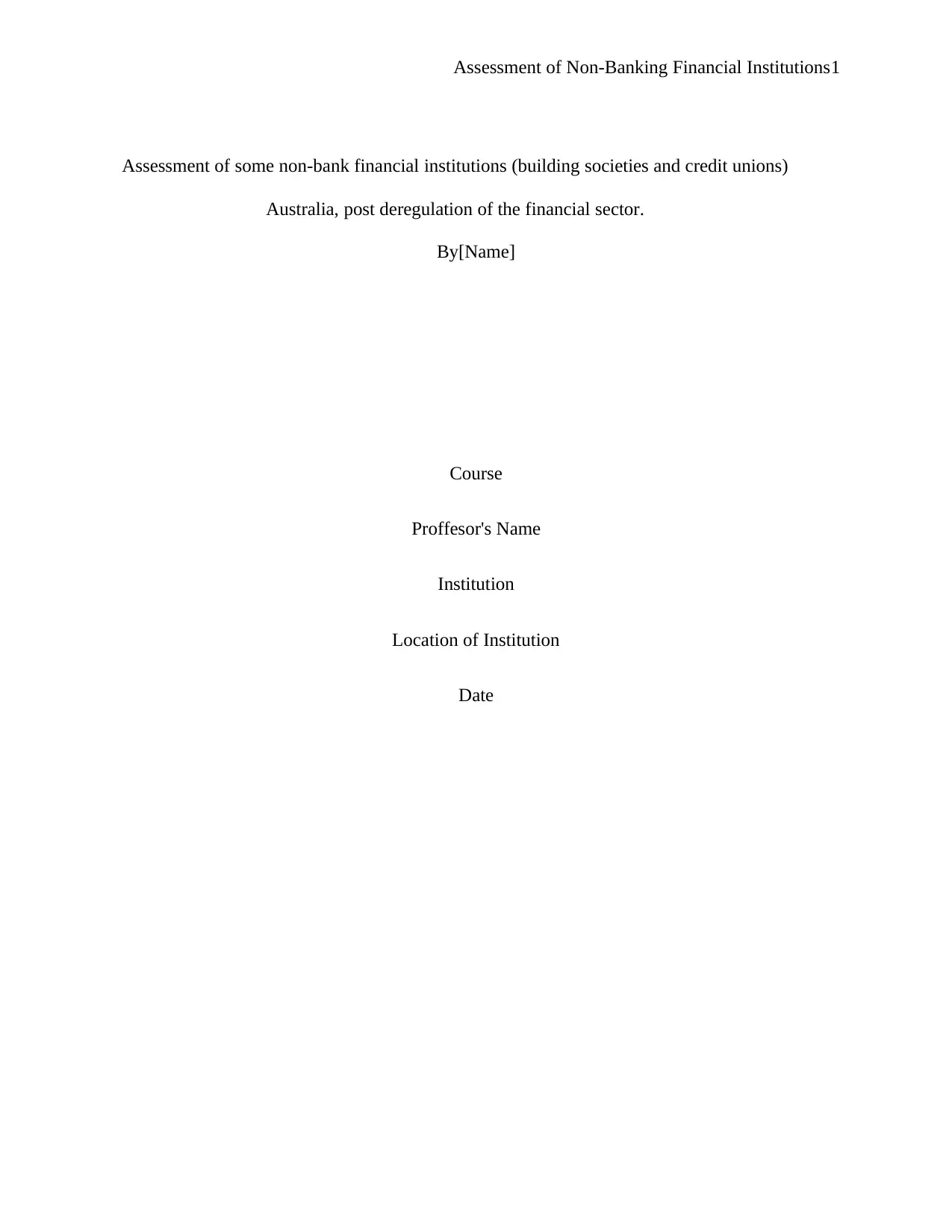
Assessment of Non-Banking Financial Institutions1
Assessment of some non-bank financial institutions (building societies and credit unions)
Australia, post deregulation of the financial sector.
By[Name]
Course
Proffesor's Name
Institution
Location of Institution
Date
Assessment of some non-bank financial institutions (building societies and credit unions)
Australia, post deregulation of the financial sector.
By[Name]
Course
Proffesor's Name
Institution
Location of Institution
Date
Paraphrase This Document
Need a fresh take? Get an instant paraphrase of this document with our AI Paraphraser
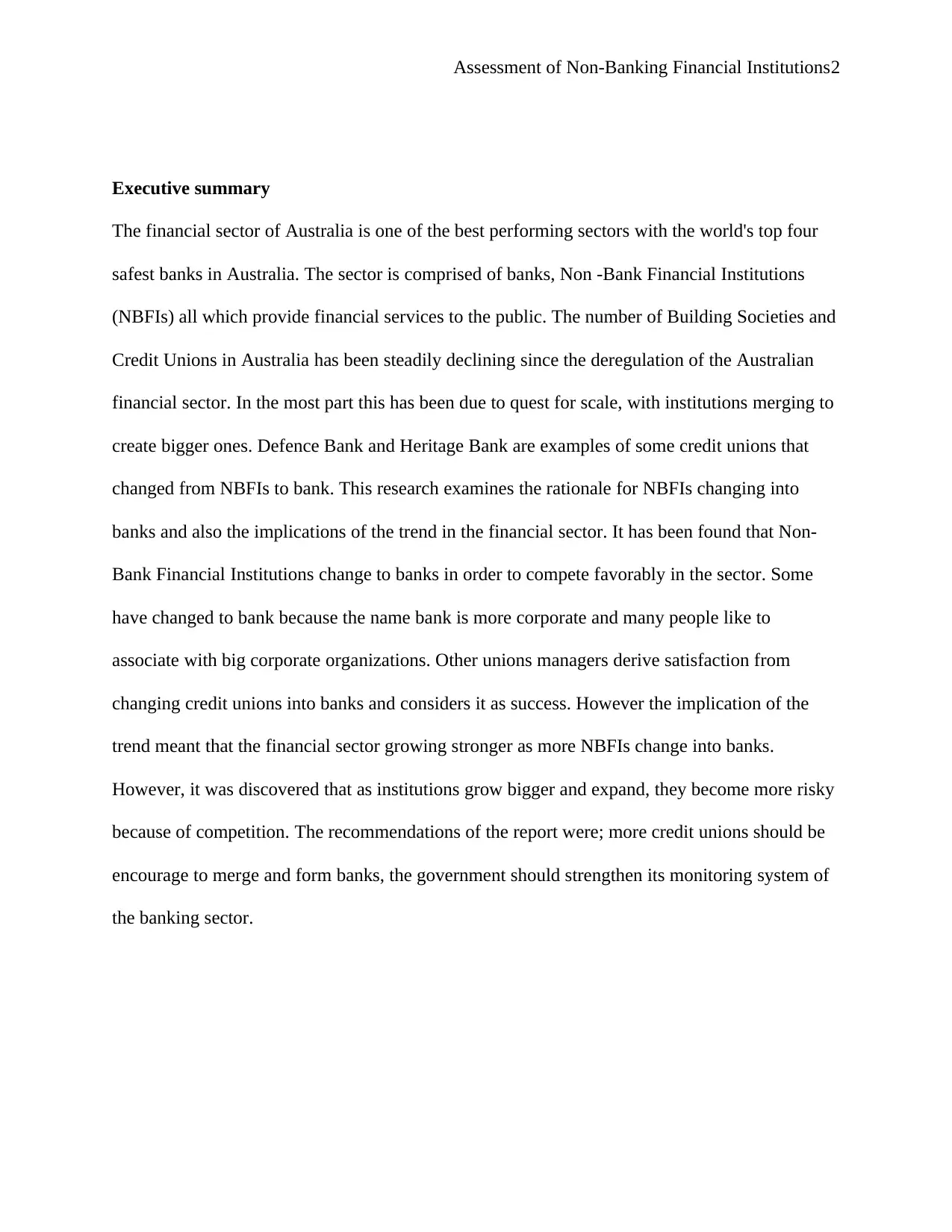
Assessment of Non-Banking Financial Institutions2
Executive summary
The financial sector of Australia is one of the best performing sectors with the world's top four
safest banks in Australia. The sector is comprised of banks, Non -Bank Financial Institutions
(NBFIs) all which provide financial services to the public. The number of Building Societies and
Credit Unions in Australia has been steadily declining since the deregulation of the Australian
financial sector. In the most part this has been due to quest for scale, with institutions merging to
create bigger ones. Defence Bank and Heritage Bank are examples of some credit unions that
changed from NBFIs to bank. This research examines the rationale for NBFIs changing into
banks and also the implications of the trend in the financial sector. It has been found that Non-
Bank Financial Institutions change to banks in order to compete favorably in the sector. Some
have changed to bank because the name bank is more corporate and many people like to
associate with big corporate organizations. Other unions managers derive satisfaction from
changing credit unions into banks and considers it as success. However the implication of the
trend meant that the financial sector growing stronger as more NBFIs change into banks.
However, it was discovered that as institutions grow bigger and expand, they become more risky
because of competition. The recommendations of the report were; more credit unions should be
encourage to merge and form banks, the government should strengthen its monitoring system of
the banking sector.
Executive summary
The financial sector of Australia is one of the best performing sectors with the world's top four
safest banks in Australia. The sector is comprised of banks, Non -Bank Financial Institutions
(NBFIs) all which provide financial services to the public. The number of Building Societies and
Credit Unions in Australia has been steadily declining since the deregulation of the Australian
financial sector. In the most part this has been due to quest for scale, with institutions merging to
create bigger ones. Defence Bank and Heritage Bank are examples of some credit unions that
changed from NBFIs to bank. This research examines the rationale for NBFIs changing into
banks and also the implications of the trend in the financial sector. It has been found that Non-
Bank Financial Institutions change to banks in order to compete favorably in the sector. Some
have changed to bank because the name bank is more corporate and many people like to
associate with big corporate organizations. Other unions managers derive satisfaction from
changing credit unions into banks and considers it as success. However the implication of the
trend meant that the financial sector growing stronger as more NBFIs change into banks.
However, it was discovered that as institutions grow bigger and expand, they become more risky
because of competition. The recommendations of the report were; more credit unions should be
encourage to merge and form banks, the government should strengthen its monitoring system of
the banking sector.
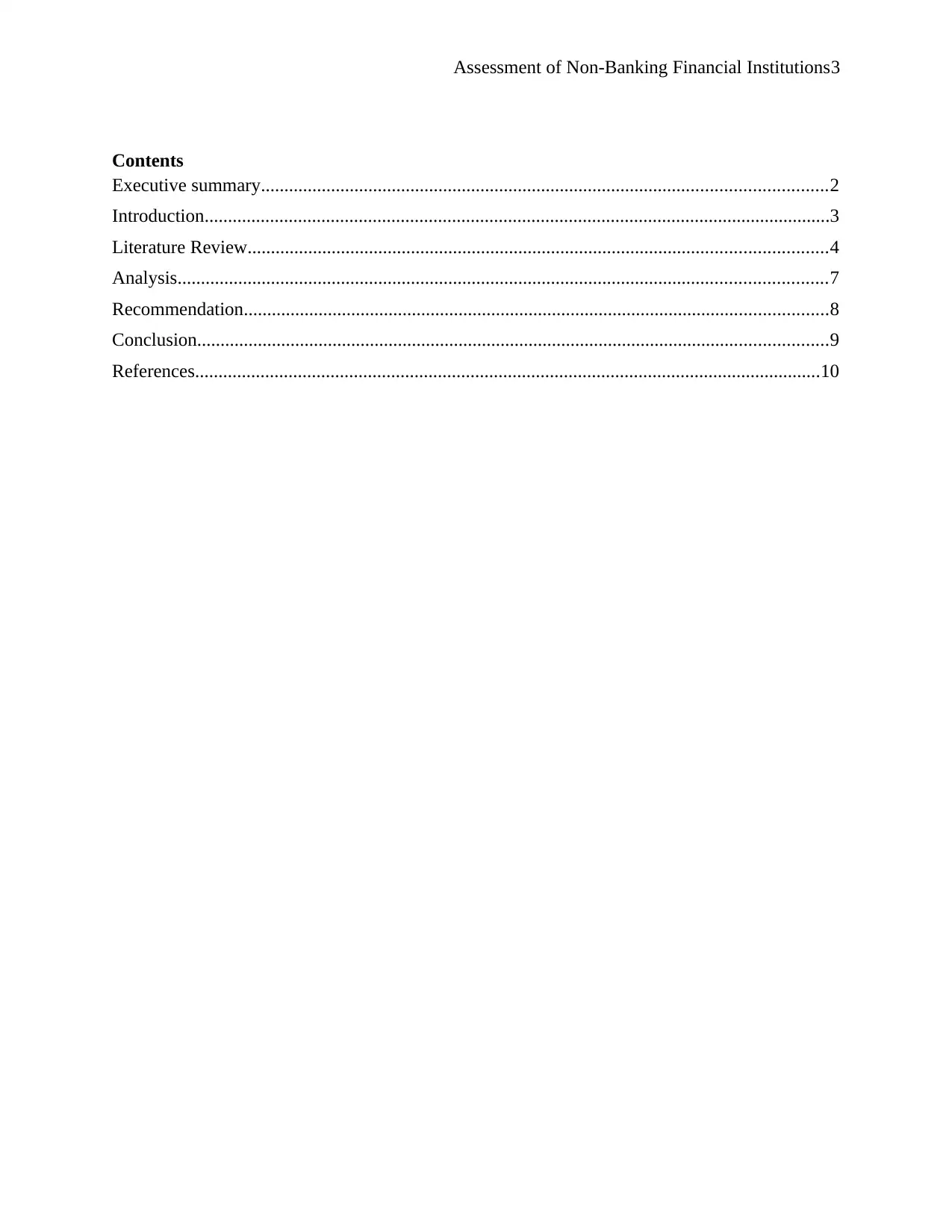
Assessment of Non-Banking Financial Institutions3
Contents
Executive summary.........................................................................................................................2
Introduction......................................................................................................................................3
Literature Review............................................................................................................................4
Analysis...........................................................................................................................................7
Recommendation.............................................................................................................................8
Conclusion.......................................................................................................................................9
References......................................................................................................................................10
Contents
Executive summary.........................................................................................................................2
Introduction......................................................................................................................................3
Literature Review............................................................................................................................4
Analysis...........................................................................................................................................7
Recommendation.............................................................................................................................8
Conclusion.......................................................................................................................................9
References......................................................................................................................................10
⊘ This is a preview!⊘
Do you want full access?
Subscribe today to unlock all pages.

Trusted by 1+ million students worldwide
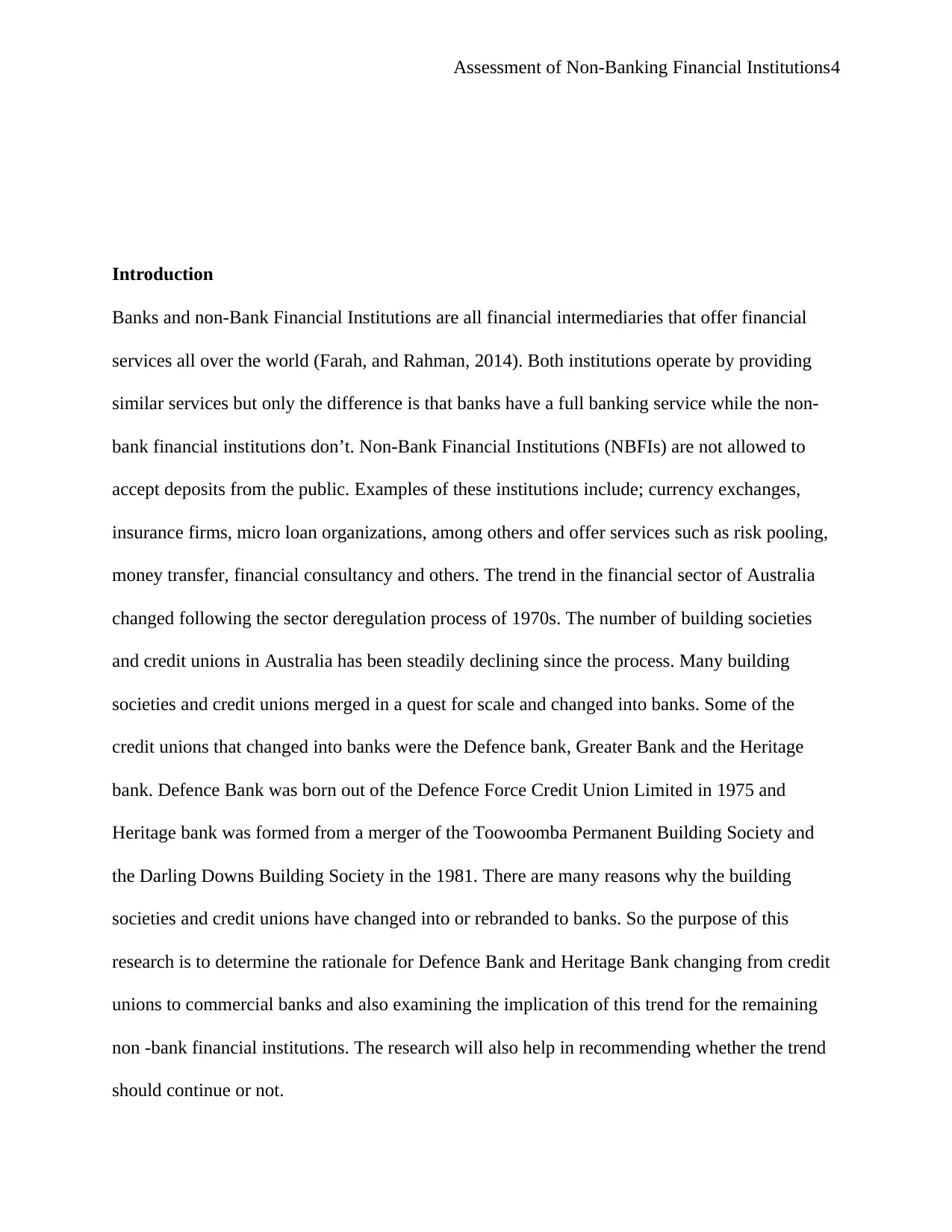
Assessment of Non-Banking Financial Institutions4
Introduction
Banks and non-Bank Financial Institutions are all financial intermediaries that offer financial
services all over the world (Farah, and Rahman, 2014). Both institutions operate by providing
similar services but only the difference is that banks have a full banking service while the non-
bank financial institutions don’t. Non-Bank Financial Institutions (NBFIs) are not allowed to
accept deposits from the public. Examples of these institutions include; currency exchanges,
insurance firms, micro loan organizations, among others and offer services such as risk pooling,
money transfer, financial consultancy and others. The trend in the financial sector of Australia
changed following the sector deregulation process of 1970s. The number of building societies
and credit unions in Australia has been steadily declining since the process. Many building
societies and credit unions merged in a quest for scale and changed into banks. Some of the
credit unions that changed into banks were the Defence bank, Greater Bank and the Heritage
bank. Defence Bank was born out of the Defence Force Credit Union Limited in 1975 and
Heritage bank was formed from a merger of the Toowoomba Permanent Building Society and
the Darling Downs Building Society in the 1981. There are many reasons why the building
societies and credit unions have changed into or rebranded to banks. So the purpose of this
research is to determine the rationale for Defence Bank and Heritage Bank changing from credit
unions to commercial banks and also examining the implication of this trend for the remaining
non -bank financial institutions. The research will also help in recommending whether the trend
should continue or not.
Introduction
Banks and non-Bank Financial Institutions are all financial intermediaries that offer financial
services all over the world (Farah, and Rahman, 2014). Both institutions operate by providing
similar services but only the difference is that banks have a full banking service while the non-
bank financial institutions don’t. Non-Bank Financial Institutions (NBFIs) are not allowed to
accept deposits from the public. Examples of these institutions include; currency exchanges,
insurance firms, micro loan organizations, among others and offer services such as risk pooling,
money transfer, financial consultancy and others. The trend in the financial sector of Australia
changed following the sector deregulation process of 1970s. The number of building societies
and credit unions in Australia has been steadily declining since the process. Many building
societies and credit unions merged in a quest for scale and changed into banks. Some of the
credit unions that changed into banks were the Defence bank, Greater Bank and the Heritage
bank. Defence Bank was born out of the Defence Force Credit Union Limited in 1975 and
Heritage bank was formed from a merger of the Toowoomba Permanent Building Society and
the Darling Downs Building Society in the 1981. There are many reasons why the building
societies and credit unions have changed into or rebranded to banks. So the purpose of this
research is to determine the rationale for Defence Bank and Heritage Bank changing from credit
unions to commercial banks and also examining the implication of this trend for the remaining
non -bank financial institutions. The research will also help in recommending whether the trend
should continue or not.
Paraphrase This Document
Need a fresh take? Get an instant paraphrase of this document with our AI Paraphraser
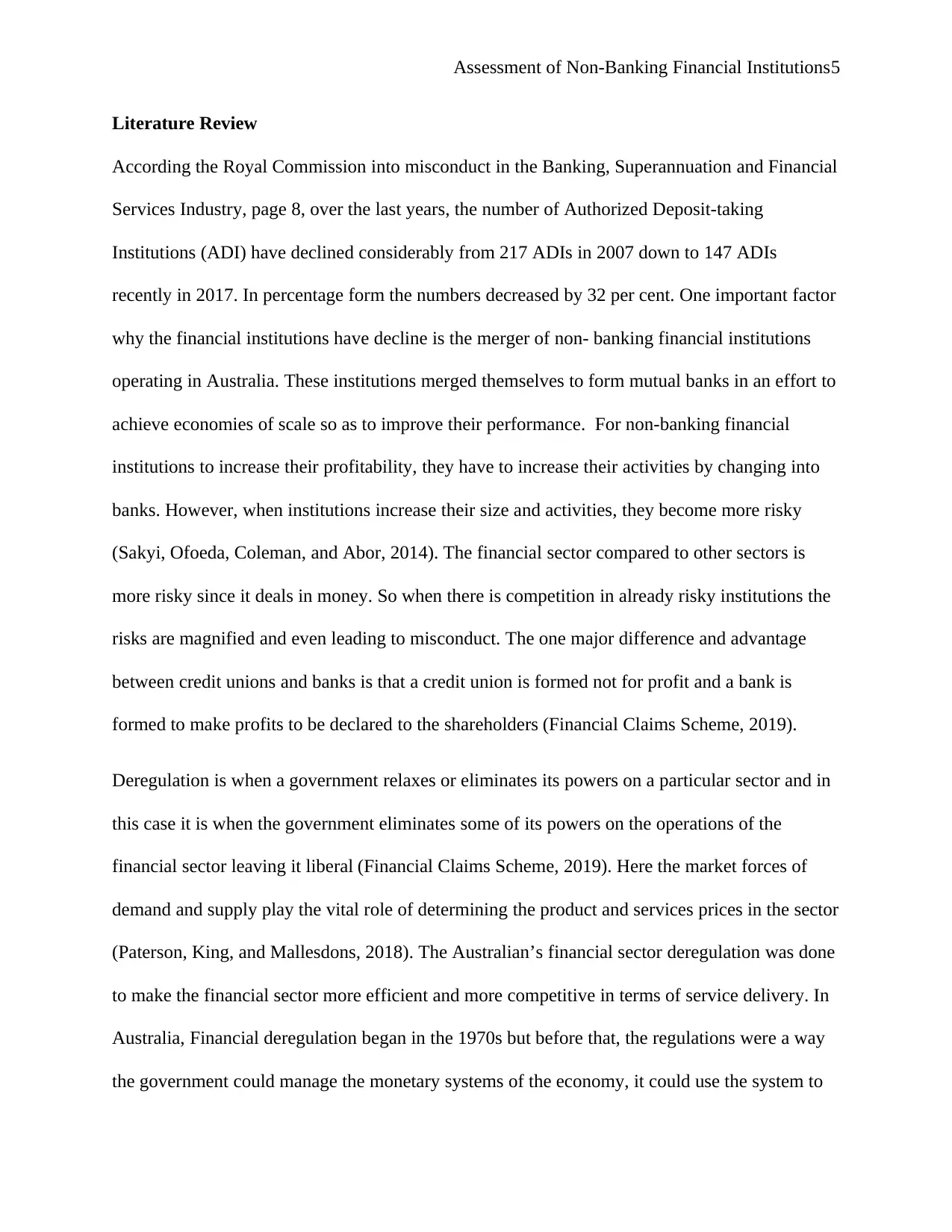
Assessment of Non-Banking Financial Institutions5
Literature Review
According the Royal Commission into misconduct in the Banking, Superannuation and Financial
Services Industry, page 8, over the last years, the number of Authorized Deposit-taking
Institutions (ADI) have declined considerably from 217 ADIs in 2007 down to 147 ADIs
recently in 2017. In percentage form the numbers decreased by 32 per cent. One important factor
why the financial institutions have decline is the merger of non- banking financial institutions
operating in Australia. These institutions merged themselves to form mutual banks in an effort to
achieve economies of scale so as to improve their performance. For non-banking financial
institutions to increase their profitability, they have to increase their activities by changing into
banks. However, when institutions increase their size and activities, they become more risky
(Sakyi, Ofoeda, Coleman, and Abor, 2014). The financial sector compared to other sectors is
more risky since it deals in money. So when there is competition in already risky institutions the
risks are magnified and even leading to misconduct. The one major difference and advantage
between credit unions and banks is that a credit union is formed not for profit and a bank is
formed to make profits to be declared to the shareholders (Financial Claims Scheme, 2019).
Deregulation is when a government relaxes or eliminates its powers on a particular sector and in
this case it is when the government eliminates some of its powers on the operations of the
financial sector leaving it liberal (Financial Claims Scheme, 2019). Here the market forces of
demand and supply play the vital role of determining the product and services prices in the sector
(Paterson, King, and Mallesdons, 2018). The Australian’s financial sector deregulation was done
to make the financial sector more efficient and more competitive in terms of service delivery. In
Australia, Financial deregulation began in the 1970s but before that, the regulations were a way
the government could manage the monetary systems of the economy, it could use the system to
Literature Review
According the Royal Commission into misconduct in the Banking, Superannuation and Financial
Services Industry, page 8, over the last years, the number of Authorized Deposit-taking
Institutions (ADI) have declined considerably from 217 ADIs in 2007 down to 147 ADIs
recently in 2017. In percentage form the numbers decreased by 32 per cent. One important factor
why the financial institutions have decline is the merger of non- banking financial institutions
operating in Australia. These institutions merged themselves to form mutual banks in an effort to
achieve economies of scale so as to improve their performance. For non-banking financial
institutions to increase their profitability, they have to increase their activities by changing into
banks. However, when institutions increase their size and activities, they become more risky
(Sakyi, Ofoeda, Coleman, and Abor, 2014). The financial sector compared to other sectors is
more risky since it deals in money. So when there is competition in already risky institutions the
risks are magnified and even leading to misconduct. The one major difference and advantage
between credit unions and banks is that a credit union is formed not for profit and a bank is
formed to make profits to be declared to the shareholders (Financial Claims Scheme, 2019).
Deregulation is when a government relaxes or eliminates its powers on a particular sector and in
this case it is when the government eliminates some of its powers on the operations of the
financial sector leaving it liberal (Financial Claims Scheme, 2019). Here the market forces of
demand and supply play the vital role of determining the product and services prices in the sector
(Paterson, King, and Mallesdons, 2018). The Australian’s financial sector deregulation was done
to make the financial sector more efficient and more competitive in terms of service delivery. In
Australia, Financial deregulation began in the 1970s but before that, the regulations were a way
the government could manage the monetary systems of the economy, it could use the system to
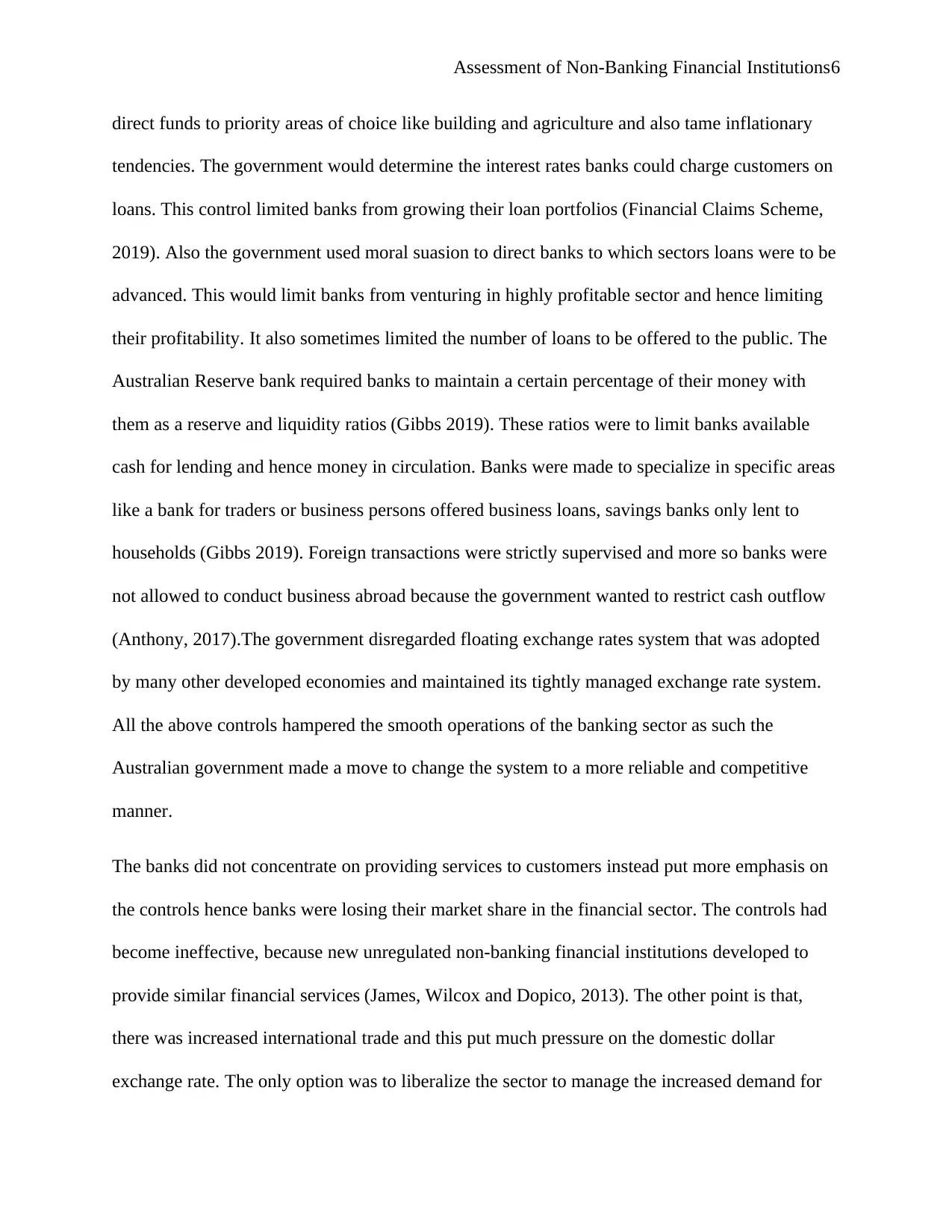
Assessment of Non-Banking Financial Institutions6
direct funds to priority areas of choice like building and agriculture and also tame inflationary
tendencies. The government would determine the interest rates banks could charge customers on
loans. This control limited banks from growing their loan portfolios (Financial Claims Scheme,
2019). Also the government used moral suasion to direct banks to which sectors loans were to be
advanced. This would limit banks from venturing in highly profitable sector and hence limiting
their profitability. It also sometimes limited the number of loans to be offered to the public. The
Australian Reserve bank required banks to maintain a certain percentage of their money with
them as a reserve and liquidity ratios (Gibbs 2019). These ratios were to limit banks available
cash for lending and hence money in circulation. Banks were made to specialize in specific areas
like a bank for traders or business persons offered business loans, savings banks only lent to
households (Gibbs 2019). Foreign transactions were strictly supervised and more so banks were
not allowed to conduct business abroad because the government wanted to restrict cash outflow
(Anthony, 2017).The government disregarded floating exchange rates system that was adopted
by many other developed economies and maintained its tightly managed exchange rate system.
All the above controls hampered the smooth operations of the banking sector as such the
Australian government made a move to change the system to a more reliable and competitive
manner.
The banks did not concentrate on providing services to customers instead put more emphasis on
the controls hence banks were losing their market share in the financial sector. The controls had
become ineffective, because new unregulated non-banking financial institutions developed to
provide similar financial services (James, Wilcox and Dopico, 2013). The other point is that,
there was increased international trade and this put much pressure on the domestic dollar
exchange rate. The only option was to liberalize the sector to manage the increased demand for
direct funds to priority areas of choice like building and agriculture and also tame inflationary
tendencies. The government would determine the interest rates banks could charge customers on
loans. This control limited banks from growing their loan portfolios (Financial Claims Scheme,
2019). Also the government used moral suasion to direct banks to which sectors loans were to be
advanced. This would limit banks from venturing in highly profitable sector and hence limiting
their profitability. It also sometimes limited the number of loans to be offered to the public. The
Australian Reserve bank required banks to maintain a certain percentage of their money with
them as a reserve and liquidity ratios (Gibbs 2019). These ratios were to limit banks available
cash for lending and hence money in circulation. Banks were made to specialize in specific areas
like a bank for traders or business persons offered business loans, savings banks only lent to
households (Gibbs 2019). Foreign transactions were strictly supervised and more so banks were
not allowed to conduct business abroad because the government wanted to restrict cash outflow
(Anthony, 2017).The government disregarded floating exchange rates system that was adopted
by many other developed economies and maintained its tightly managed exchange rate system.
All the above controls hampered the smooth operations of the banking sector as such the
Australian government made a move to change the system to a more reliable and competitive
manner.
The banks did not concentrate on providing services to customers instead put more emphasis on
the controls hence banks were losing their market share in the financial sector. The controls had
become ineffective, because new unregulated non-banking financial institutions developed to
provide similar financial services (James, Wilcox and Dopico, 2013). The other point is that,
there was increased international trade and this put much pressure on the domestic dollar
exchange rate. The only option was to liberalize the sector to manage the increased demand for
⊘ This is a preview!⊘
Do you want full access?
Subscribe today to unlock all pages.

Trusted by 1+ million students worldwide
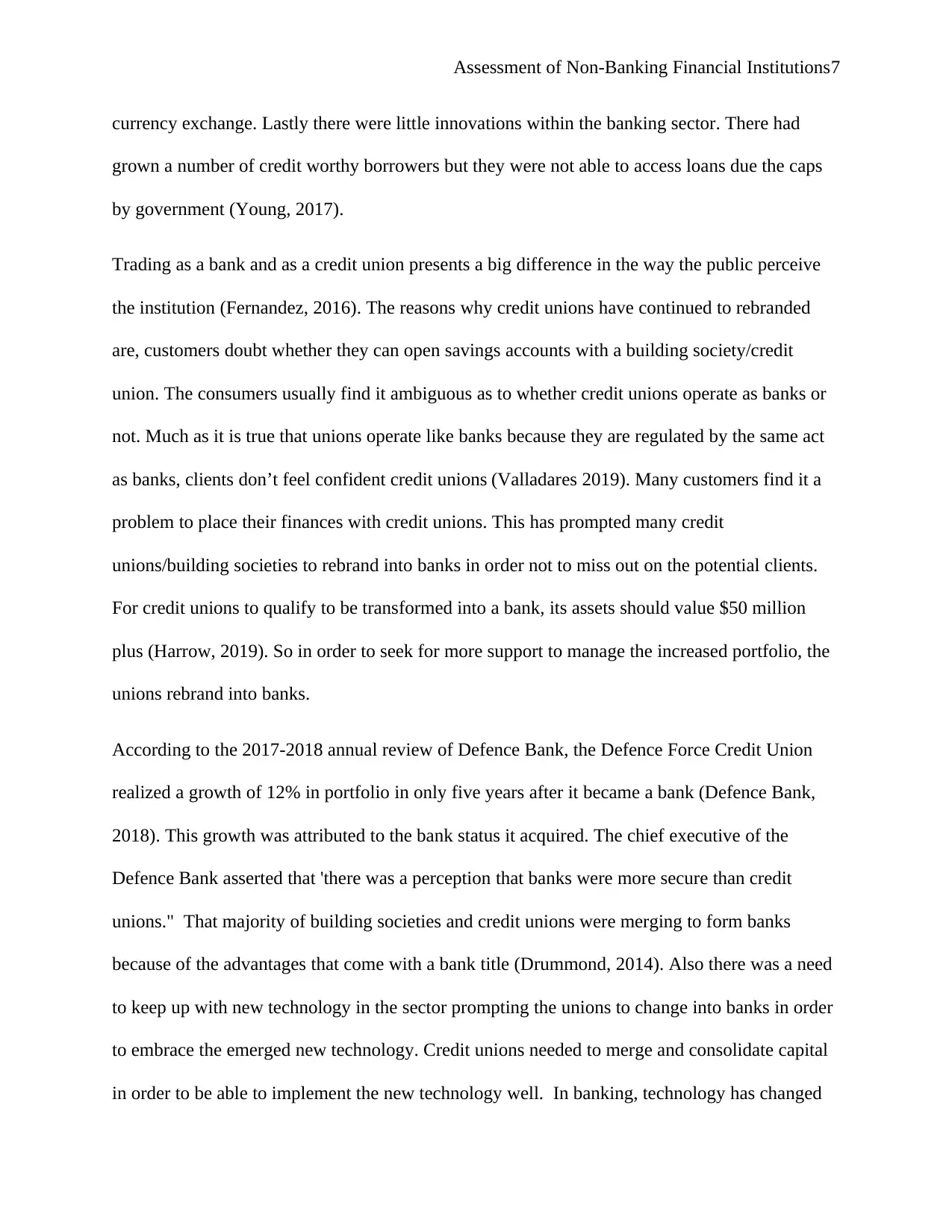
Assessment of Non-Banking Financial Institutions7
currency exchange. Lastly there were little innovations within the banking sector. There had
grown a number of credit worthy borrowers but they were not able to access loans due the caps
by government (Young, 2017).
Trading as a bank and as a credit union presents a big difference in the way the public perceive
the institution (Fernandez, 2016). The reasons why credit unions have continued to rebranded
are, customers doubt whether they can open savings accounts with a building society/credit
union. The consumers usually find it ambiguous as to whether credit unions operate as banks or
not. Much as it is true that unions operate like banks because they are regulated by the same act
as banks, clients don’t feel confident credit unions (Valladares 2019). Many customers find it a
problem to place their finances with credit unions. This has prompted many credit
unions/building societies to rebrand into banks in order not to miss out on the potential clients.
For credit unions to qualify to be transformed into a bank, its assets should value $50 million
plus (Harrow, 2019). So in order to seek for more support to manage the increased portfolio, the
unions rebrand into banks.
According to the 2017-2018 annual review of Defence Bank, the Defence Force Credit Union
realized a growth of 12% in portfolio in only five years after it became a bank (Defence Bank,
2018). This growth was attributed to the bank status it acquired. The chief executive of the
Defence Bank asserted that 'there was a perception that banks were more secure than credit
unions." That majority of building societies and credit unions were merging to form banks
because of the advantages that come with a bank title (Drummond, 2014). Also there was a need
to keep up with new technology in the sector prompting the unions to change into banks in order
to embrace the emerged new technology. Credit unions needed to merge and consolidate capital
in order to be able to implement the new technology well. In banking, technology has changed
currency exchange. Lastly there were little innovations within the banking sector. There had
grown a number of credit worthy borrowers but they were not able to access loans due the caps
by government (Young, 2017).
Trading as a bank and as a credit union presents a big difference in the way the public perceive
the institution (Fernandez, 2016). The reasons why credit unions have continued to rebranded
are, customers doubt whether they can open savings accounts with a building society/credit
union. The consumers usually find it ambiguous as to whether credit unions operate as banks or
not. Much as it is true that unions operate like banks because they are regulated by the same act
as banks, clients don’t feel confident credit unions (Valladares 2019). Many customers find it a
problem to place their finances with credit unions. This has prompted many credit
unions/building societies to rebrand into banks in order not to miss out on the potential clients.
For credit unions to qualify to be transformed into a bank, its assets should value $50 million
plus (Harrow, 2019). So in order to seek for more support to manage the increased portfolio, the
unions rebrand into banks.
According to the 2017-2018 annual review of Defence Bank, the Defence Force Credit Union
realized a growth of 12% in portfolio in only five years after it became a bank (Defence Bank,
2018). This growth was attributed to the bank status it acquired. The chief executive of the
Defence Bank asserted that 'there was a perception that banks were more secure than credit
unions." That majority of building societies and credit unions were merging to form banks
because of the advantages that come with a bank title (Drummond, 2014). Also there was a need
to keep up with new technology in the sector prompting the unions to change into banks in order
to embrace the emerged new technology. Credit unions needed to merge and consolidate capital
in order to be able to implement the new technology well. In banking, technology has changed
Paraphrase This Document
Need a fresh take? Get an instant paraphrase of this document with our AI Paraphraser
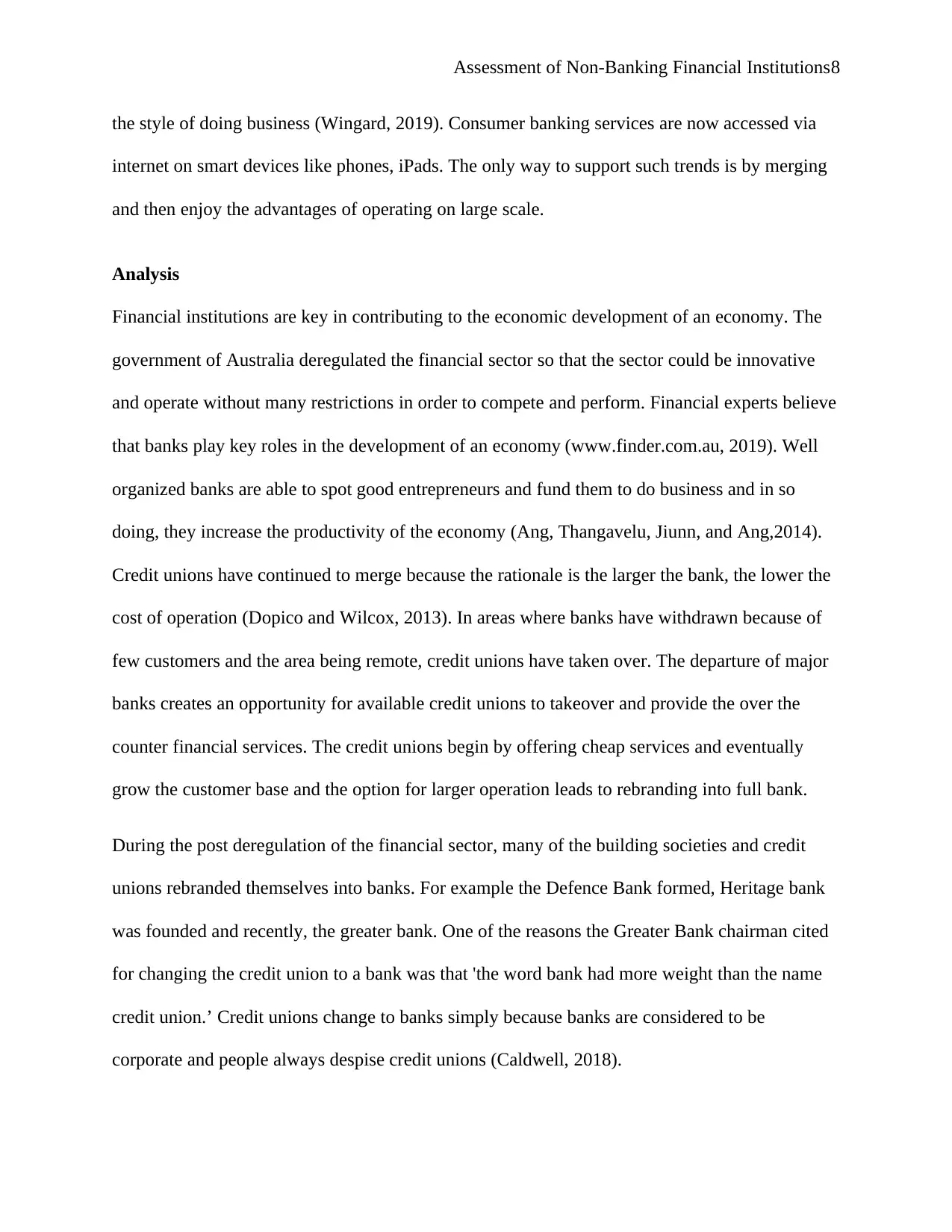
Assessment of Non-Banking Financial Institutions8
the style of doing business (Wingard, 2019). Consumer banking services are now accessed via
internet on smart devices like phones, iPads. The only way to support such trends is by merging
and then enjoy the advantages of operating on large scale.
Analysis
Financial institutions are key in contributing to the economic development of an economy. The
government of Australia deregulated the financial sector so that the sector could be innovative
and operate without many restrictions in order to compete and perform. Financial experts believe
that banks play key roles in the development of an economy (www.finder.com.au, 2019). Well
organized banks are able to spot good entrepreneurs and fund them to do business and in so
doing, they increase the productivity of the economy (Ang, Thangavelu, Jiunn, and Ang,2014).
Credit unions have continued to merge because the rationale is the larger the bank, the lower the
cost of operation (Dopico and Wilcox, 2013). In areas where banks have withdrawn because of
few customers and the area being remote, credit unions have taken over. The departure of major
banks creates an opportunity for available credit unions to takeover and provide the over the
counter financial services. The credit unions begin by offering cheap services and eventually
grow the customer base and the option for larger operation leads to rebranding into full bank.
During the post deregulation of the financial sector, many of the building societies and credit
unions rebranded themselves into banks. For example the Defence Bank formed, Heritage bank
was founded and recently, the greater bank. One of the reasons the Greater Bank chairman cited
for changing the credit union to a bank was that 'the word bank had more weight than the name
credit union.’ Credit unions change to banks simply because banks are considered to be
corporate and people always despise credit unions (Caldwell, 2018).
the style of doing business (Wingard, 2019). Consumer banking services are now accessed via
internet on smart devices like phones, iPads. The only way to support such trends is by merging
and then enjoy the advantages of operating on large scale.
Analysis
Financial institutions are key in contributing to the economic development of an economy. The
government of Australia deregulated the financial sector so that the sector could be innovative
and operate without many restrictions in order to compete and perform. Financial experts believe
that banks play key roles in the development of an economy (www.finder.com.au, 2019). Well
organized banks are able to spot good entrepreneurs and fund them to do business and in so
doing, they increase the productivity of the economy (Ang, Thangavelu, Jiunn, and Ang,2014).
Credit unions have continued to merge because the rationale is the larger the bank, the lower the
cost of operation (Dopico and Wilcox, 2013). In areas where banks have withdrawn because of
few customers and the area being remote, credit unions have taken over. The departure of major
banks creates an opportunity for available credit unions to takeover and provide the over the
counter financial services. The credit unions begin by offering cheap services and eventually
grow the customer base and the option for larger operation leads to rebranding into full bank.
During the post deregulation of the financial sector, many of the building societies and credit
unions rebranded themselves into banks. For example the Defence Bank formed, Heritage bank
was founded and recently, the greater bank. One of the reasons the Greater Bank chairman cited
for changing the credit union to a bank was that 'the word bank had more weight than the name
credit union.’ Credit unions change to banks simply because banks are considered to be
corporate and people always despise credit unions (Caldwell, 2018).
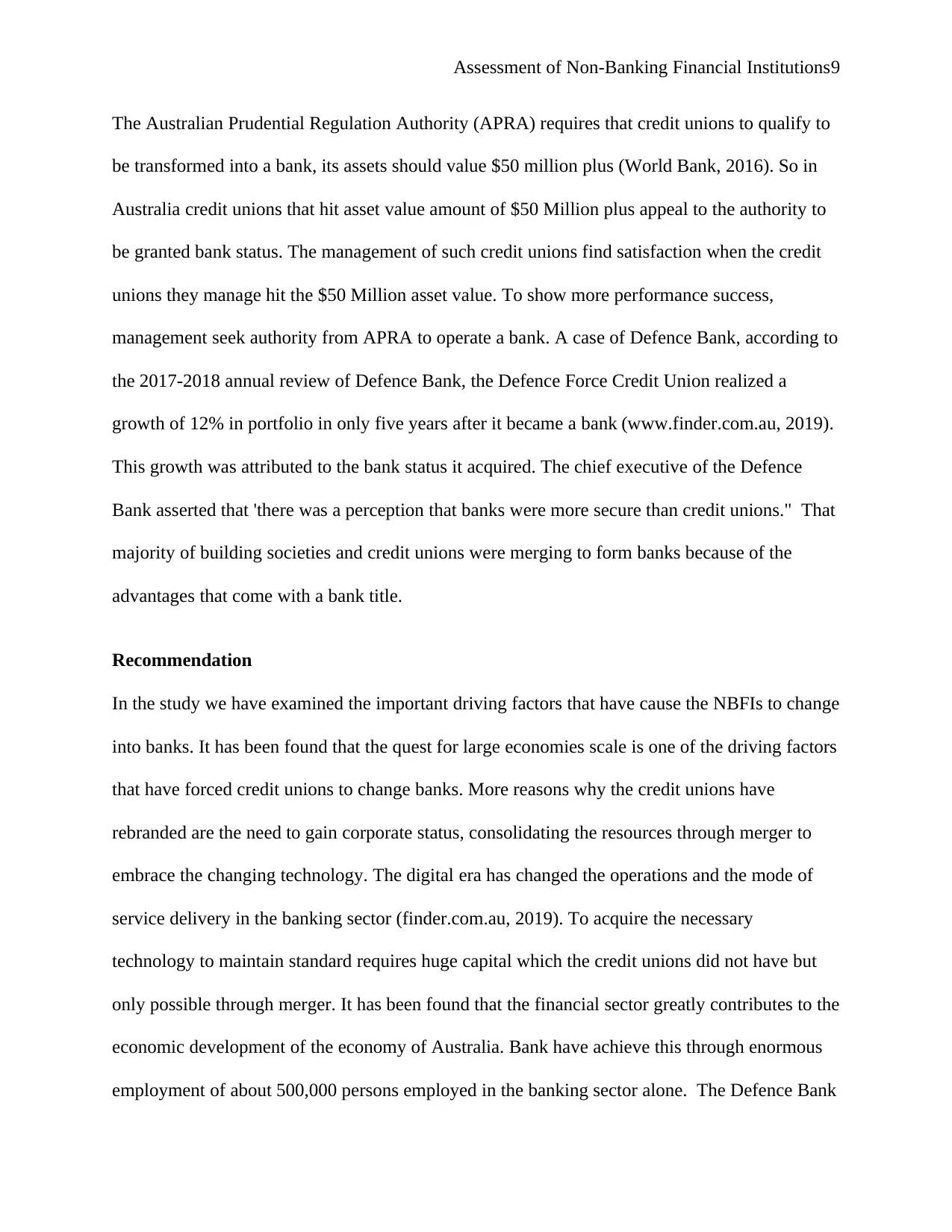
Assessment of Non-Banking Financial Institutions9
The Australian Prudential Regulation Authority (APRA) requires that credit unions to qualify to
be transformed into a bank, its assets should value $50 million plus (World Bank, 2016). So in
Australia credit unions that hit asset value amount of $50 Million plus appeal to the authority to
be granted bank status. The management of such credit unions find satisfaction when the credit
unions they manage hit the $50 Million asset value. To show more performance success,
management seek authority from APRA to operate a bank. A case of Defence Bank, according to
the 2017-2018 annual review of Defence Bank, the Defence Force Credit Union realized a
growth of 12% in portfolio in only five years after it became a bank (www.finder.com.au, 2019).
This growth was attributed to the bank status it acquired. The chief executive of the Defence
Bank asserted that 'there was a perception that banks were more secure than credit unions." That
majority of building societies and credit unions were merging to form banks because of the
advantages that come with a bank title.
Recommendation
In the study we have examined the important driving factors that have cause the NBFIs to change
into banks. It has been found that the quest for large economies scale is one of the driving factors
that have forced credit unions to change banks. More reasons why the credit unions have
rebranded are the need to gain corporate status, consolidating the resources through merger to
embrace the changing technology. The digital era has changed the operations and the mode of
service delivery in the banking sector (finder.com.au, 2019). To acquire the necessary
technology to maintain standard requires huge capital which the credit unions did not have but
only possible through merger. It has been found that the financial sector greatly contributes to the
economic development of the economy of Australia. Bank have achieve this through enormous
employment of about 500,000 persons employed in the banking sector alone. The Defence Bank
The Australian Prudential Regulation Authority (APRA) requires that credit unions to qualify to
be transformed into a bank, its assets should value $50 million plus (World Bank, 2016). So in
Australia credit unions that hit asset value amount of $50 Million plus appeal to the authority to
be granted bank status. The management of such credit unions find satisfaction when the credit
unions they manage hit the $50 Million asset value. To show more performance success,
management seek authority from APRA to operate a bank. A case of Defence Bank, according to
the 2017-2018 annual review of Defence Bank, the Defence Force Credit Union realized a
growth of 12% in portfolio in only five years after it became a bank (www.finder.com.au, 2019).
This growth was attributed to the bank status it acquired. The chief executive of the Defence
Bank asserted that 'there was a perception that banks were more secure than credit unions." That
majority of building societies and credit unions were merging to form banks because of the
advantages that come with a bank title.
Recommendation
In the study we have examined the important driving factors that have cause the NBFIs to change
into banks. It has been found that the quest for large economies scale is one of the driving factors
that have forced credit unions to change banks. More reasons why the credit unions have
rebranded are the need to gain corporate status, consolidating the resources through merger to
embrace the changing technology. The digital era has changed the operations and the mode of
service delivery in the banking sector (finder.com.au, 2019). To acquire the necessary
technology to maintain standard requires huge capital which the credit unions did not have but
only possible through merger. It has been found that the financial sector greatly contributes to the
economic development of the economy of Australia. Bank have achieve this through enormous
employment of about 500,000 persons employed in the banking sector alone. The Defence Bank
⊘ This is a preview!⊘
Do you want full access?
Subscribe today to unlock all pages.

Trusted by 1+ million students worldwide
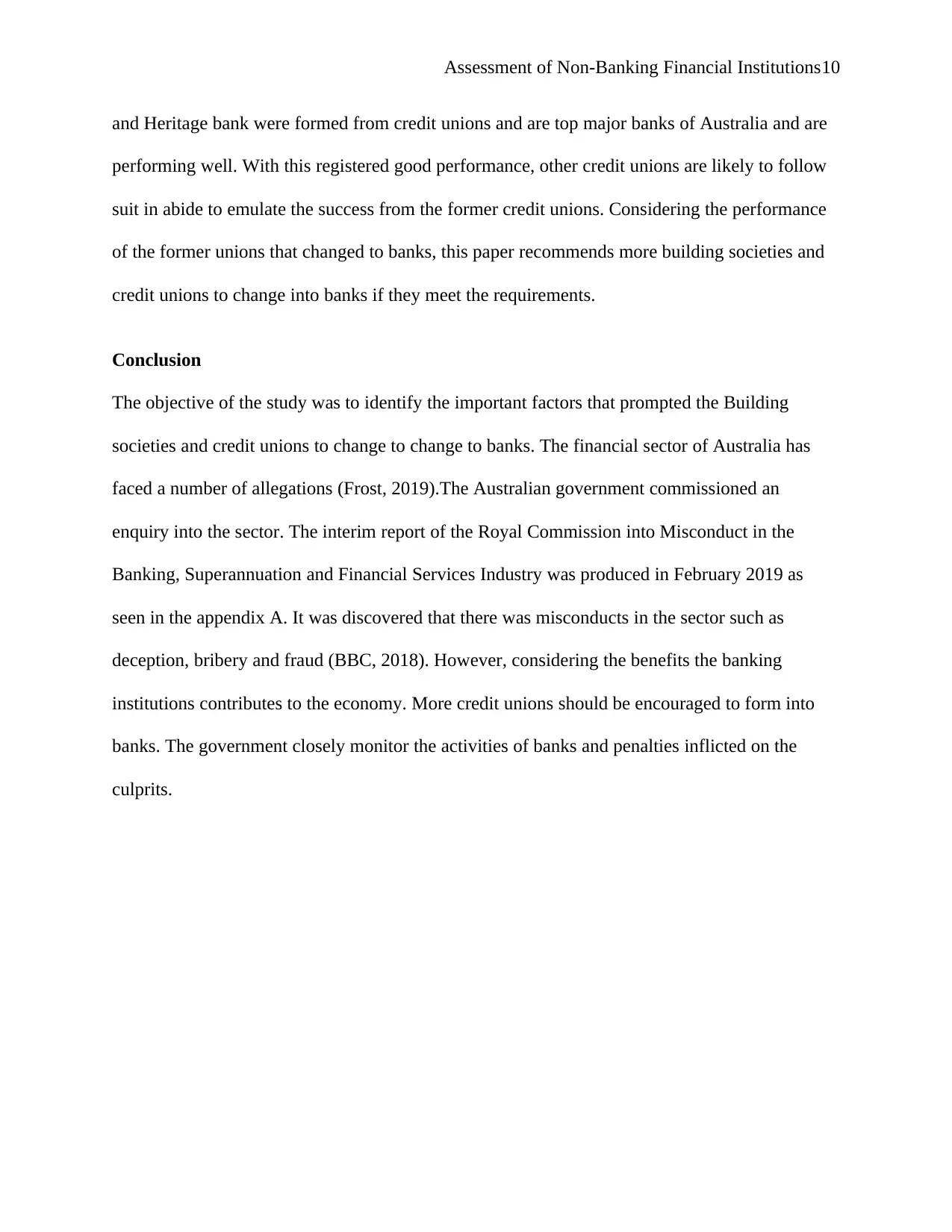
Assessment of Non-Banking Financial Institutions10
and Heritage bank were formed from credit unions and are top major banks of Australia and are
performing well. With this registered good performance, other credit unions are likely to follow
suit in abide to emulate the success from the former credit unions. Considering the performance
of the former unions that changed to banks, this paper recommends more building societies and
credit unions to change into banks if they meet the requirements.
Conclusion
The objective of the study was to identify the important factors that prompted the Building
societies and credit unions to change to change to banks. The financial sector of Australia has
faced a number of allegations (Frost, 2019).The Australian government commissioned an
enquiry into the sector. The interim report of the Royal Commission into Misconduct in the
Banking, Superannuation and Financial Services Industry was produced in February 2019 as
seen in the appendix A. It was discovered that there was misconducts in the sector such as
deception, bribery and fraud (BBC, 2018). However, considering the benefits the banking
institutions contributes to the economy. More credit unions should be encouraged to form into
banks. The government closely monitor the activities of banks and penalties inflicted on the
culprits.
and Heritage bank were formed from credit unions and are top major banks of Australia and are
performing well. With this registered good performance, other credit unions are likely to follow
suit in abide to emulate the success from the former credit unions. Considering the performance
of the former unions that changed to banks, this paper recommends more building societies and
credit unions to change into banks if they meet the requirements.
Conclusion
The objective of the study was to identify the important factors that prompted the Building
societies and credit unions to change to change to banks. The financial sector of Australia has
faced a number of allegations (Frost, 2019).The Australian government commissioned an
enquiry into the sector. The interim report of the Royal Commission into Misconduct in the
Banking, Superannuation and Financial Services Industry was produced in February 2019 as
seen in the appendix A. It was discovered that there was misconducts in the sector such as
deception, bribery and fraud (BBC, 2018). However, considering the benefits the banking
institutions contributes to the economy. More credit unions should be encouraged to form into
banks. The government closely monitor the activities of banks and penalties inflicted on the
culprits.
Paraphrase This Document
Need a fresh take? Get an instant paraphrase of this document with our AI Paraphraser
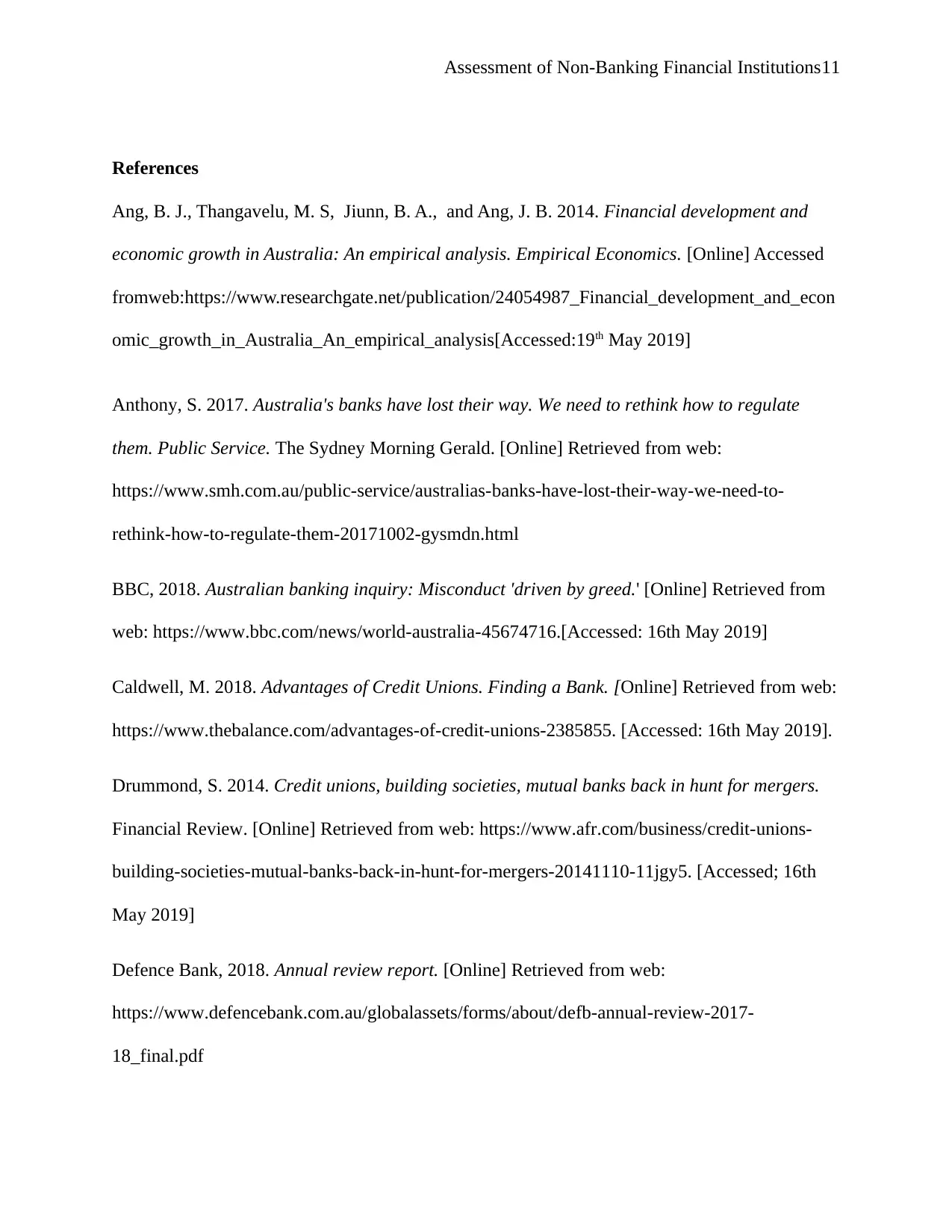
Assessment of Non-Banking Financial Institutions11
References
Ang, B. J., Thangavelu, M. S, Jiunn, B. A., and Ang, J. B. 2014. Financial development and
economic growth in Australia: An empirical analysis. Empirical Economics. [Online] Accessed
fromweb:https://www.researchgate.net/publication/24054987_Financial_development_and_econ
omic_growth_in_Australia_An_empirical_analysis[Accessed:19th May 2019]
Anthony, S. 2017. Australia's banks have lost their way. We need to rethink how to regulate
them. Public Service. The Sydney Morning Gerald. [Online] Retrieved from web:
https://www.smh.com.au/public-service/australias-banks-have-lost-their-way-we-need-to-
rethink-how-to-regulate-them-20171002-gysmdn.html
BBC, 2018. Australian banking inquiry: Misconduct 'driven by greed.' [Online] Retrieved from
web: https://www.bbc.com/news/world-australia-45674716.[Accessed: 16th May 2019]
Caldwell, M. 2018. Advantages of Credit Unions. Finding a Bank. [Online] Retrieved from web:
https://www.thebalance.com/advantages-of-credit-unions-2385855. [Accessed: 16th May 2019].
Drummond, S. 2014. Credit unions, building societies, mutual banks back in hunt for mergers.
Financial Review. [Online] Retrieved from web: https://www.afr.com/business/credit-unions-
building-societies-mutual-banks-back-in-hunt-for-mergers-20141110-11jgy5. [Accessed; 16th
May 2019]
Defence Bank, 2018. Annual review report. [Online] Retrieved from web:
https://www.defencebank.com.au/globalassets/forms/about/defb-annual-review-2017-
18_final.pdf
References
Ang, B. J., Thangavelu, M. S, Jiunn, B. A., and Ang, J. B. 2014. Financial development and
economic growth in Australia: An empirical analysis. Empirical Economics. [Online] Accessed
fromweb:https://www.researchgate.net/publication/24054987_Financial_development_and_econ
omic_growth_in_Australia_An_empirical_analysis[Accessed:19th May 2019]
Anthony, S. 2017. Australia's banks have lost their way. We need to rethink how to regulate
them. Public Service. The Sydney Morning Gerald. [Online] Retrieved from web:
https://www.smh.com.au/public-service/australias-banks-have-lost-their-way-we-need-to-
rethink-how-to-regulate-them-20171002-gysmdn.html
BBC, 2018. Australian banking inquiry: Misconduct 'driven by greed.' [Online] Retrieved from
web: https://www.bbc.com/news/world-australia-45674716.[Accessed: 16th May 2019]
Caldwell, M. 2018. Advantages of Credit Unions. Finding a Bank. [Online] Retrieved from web:
https://www.thebalance.com/advantages-of-credit-unions-2385855. [Accessed: 16th May 2019].
Drummond, S. 2014. Credit unions, building societies, mutual banks back in hunt for mergers.
Financial Review. [Online] Retrieved from web: https://www.afr.com/business/credit-unions-
building-societies-mutual-banks-back-in-hunt-for-mergers-20141110-11jgy5. [Accessed; 16th
May 2019]
Defence Bank, 2018. Annual review report. [Online] Retrieved from web:
https://www.defencebank.com.au/globalassets/forms/about/defb-annual-review-2017-
18_final.pdf

Assessment of Non-Banking Financial Institutions12
Financial Claims Scheme, 2019. List of authorized deposit-taking institutions covered under the
Financial Claims Scheme. [Online] Retrieved from the web: https://www.fcs.gov.au/which-adis-
are-covered. [Accessed: 16th May 2019]
Frost, J. 2019. NAB kills scandal-plagued home-loan referral program. Financial Review:
[Online] Retrieved from web: https://www.afr.com/business/banking-and-finance/nab-kills-
scandal-plagued-home-loan-referral-program-20190325-p5179z
Farah, T. and Rahman, S. 2014. A comparative study of bank and non -bank financial
institutions: A study of profitability indicators. Journal of banking & Financial Services. Vol 8.
1/2. 2014.
Fernandez, C. 2016. Why credit unions are rebranding. finder. [Online] Retrieved from the web:
https://www.finder.com.au/why-credit-unions-are-rebranding [Accessed: 18th May 2019]
Gibbs, M. 2019. Financial Institutions in Australia. [Online] Retrieved from web:
https://study.com/academy/lesson/financial-institutions-in-australia.html
Harrow, R. 2019. Banks vs Credit Unions: The Differences That Matter to You. Banking:
[Online] Retrieved from web: https://www.valuepenguin.com/banking/banks-vs-credit-unions
James A. Wilcox and Luis G. Dopico. 2013. Credit union mergers: efficiencies and benefits
Article (PDF Available) · January 2011 with 128 Reads
Patience Asamoah Sakyi, Isaac Ofoeda, Anthony Kyereboah-Coleman, Joshua Yindenaba Abor,
(2014). Risk and performance of non-bank financial institutions, International Journal of
Financial Services Management 7(1):19-35.
Financial Claims Scheme, 2019. List of authorized deposit-taking institutions covered under the
Financial Claims Scheme. [Online] Retrieved from the web: https://www.fcs.gov.au/which-adis-
are-covered. [Accessed: 16th May 2019]
Frost, J. 2019. NAB kills scandal-plagued home-loan referral program. Financial Review:
[Online] Retrieved from web: https://www.afr.com/business/banking-and-finance/nab-kills-
scandal-plagued-home-loan-referral-program-20190325-p5179z
Farah, T. and Rahman, S. 2014. A comparative study of bank and non -bank financial
institutions: A study of profitability indicators. Journal of banking & Financial Services. Vol 8.
1/2. 2014.
Fernandez, C. 2016. Why credit unions are rebranding. finder. [Online] Retrieved from the web:
https://www.finder.com.au/why-credit-unions-are-rebranding [Accessed: 18th May 2019]
Gibbs, M. 2019. Financial Institutions in Australia. [Online] Retrieved from web:
https://study.com/academy/lesson/financial-institutions-in-australia.html
Harrow, R. 2019. Banks vs Credit Unions: The Differences That Matter to You. Banking:
[Online] Retrieved from web: https://www.valuepenguin.com/banking/banks-vs-credit-unions
James A. Wilcox and Luis G. Dopico. 2013. Credit union mergers: efficiencies and benefits
Article (PDF Available) · January 2011 with 128 Reads
Patience Asamoah Sakyi, Isaac Ofoeda, Anthony Kyereboah-Coleman, Joshua Yindenaba Abor,
(2014). Risk and performance of non-bank financial institutions, International Journal of
Financial Services Management 7(1):19-35.
⊘ This is a preview!⊘
Do you want full access?
Subscribe today to unlock all pages.

Trusted by 1+ million students worldwide
1 out of 14
Related Documents
Your All-in-One AI-Powered Toolkit for Academic Success.
+13062052269
info@desklib.com
Available 24*7 on WhatsApp / Email
![[object Object]](/_next/static/media/star-bottom.7253800d.svg)
Unlock your academic potential
Copyright © 2020–2025 A2Z Services. All Rights Reserved. Developed and managed by ZUCOL.





